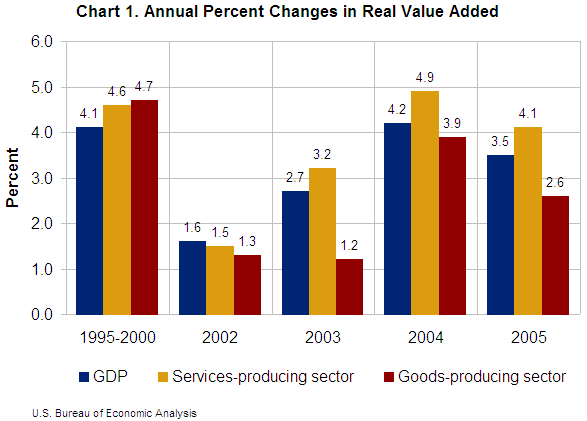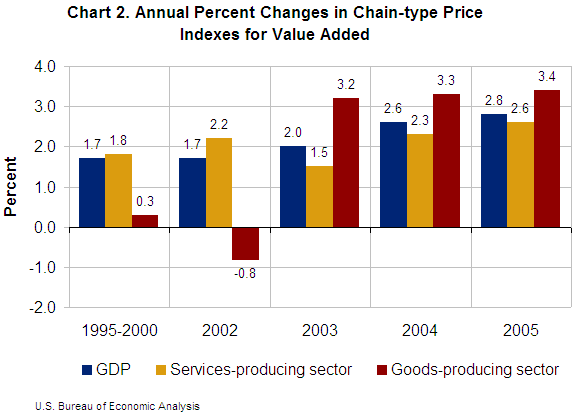News Release
Gross Domestic Product by Industry
Available for this release: Full Release (PDF - ) | Charts and Tables (XLS - ), Highlights (PDF - )
Sign up for e-mail subscriptions.
| Technical: | Erich H. Strassner: |
(202) 606-5307
|
BEA 06-16 | |
| Media: | Ralph Stewart: | 606-9690 |
Services and Goods Sectors Both Strong Despite Slowdown in 2005
Advance Estimates of Gross Domestic Product (GDP) by Industry
In 2005, both the services-producing and goods-producing sectors continued their expansion, although each sector experienced a slowdown from its pace of growth in 2004. Newly-available data on the industry distribution of real GDP growth, released today by the U.S. Bureau of Economic Analysis, showed that the services-producing sector grew 4.1 percent and continued to be led by the information and professional and business services industry groups. The goods-producing sector increased 2.6 percent reflecting growth in manufacturing and construction that more than offset declines in mining and agriculture.
Despite slower growth in 2005, the manufacturing industry group continued to show strong growth, increasing 4.0 percent after increasing 4.8 percent in 2004. Durable-goods manufacturing increased 5.7 percent and continued to lead growth for the goods-producing sector due, in part, to the continued strength of computer and electronic products.

Price growth in both the goods-producing and services-producing sectors accelerated slightly in 2005, and growth was widespread as value-added prices increased in 19 of 22 industry groups. Overall, however, price growth in both sectors remained modest by historical standards.
Strong energy price growth impacted both goods-producing and services-producing industries in 2005. In the goods-producing sector, value-added prices increased 3.4 percent above 3 percent for the third consecutive year partly reflecting continued strong price growth in mining. In addition, manufacturing prices increased for the first time since 1995 due, in part, to accelerations in petroleum-related products. Price growth accelerated to 2.6 percent in the services-producing sector and was led by transportation and warehousing at 5.0 percent.

Other highlights of the advance industry estimates for 2005 include the following:
- Information-communications-technology-producing industries experienced double-digit growth of 11.9 percent in 2005, down slightly from 12.9 percent growth in 2004. Despite comprising just 3.9 percent of current-dollar GDP in 2005, these industries accounted for 12.8 percent of real GDP growth.
- Growth in accommodation and food services accelerated to 4.8 percent in 2005, exceeding its average annual growth of 3.9 percent over the period 1995-2000. For the second consecutive year, professional, scientific, and technical services growth (7.0 percent) exceeded its average annual growth of 6.9 percent over the period 1995-2000.
- The finance, insurance, real estate, rental, and leasing (FIRE) industry group continued to contribute more than any other industry group to real GDP growth 24 percent in 2005. Overall, growth remained steady at 4.1 percent compared with 3.8 percent in 2004. Within FIRE, growth of real estate and rental and leasing slowed to 2.5 percent in 2005, down from 5.6 percent in 2004. This deceleration was more than offset by faster growth in finance and insurance of 6.7 percent in 2005, up from 1.0 percent in 2004.
Additional Information:
- The advance GDP-by-industry estimates are prepared for broad industry groups based on the 1997 North American Industry Classification System and use a methodology developed for summary source data.
| NOTE: These estimates rely heavily on industry data underlying the final 2005 fourth quarter GDP release from the national income and product accounts (NIPAs). Definitional and conceptual differences affect the comparability of some NIPA and GDP-by-industry measures. For example, in the NIPAs, the value added by goods-distribution (e.g., transport and trade) industries is included in the market value of goods. In the GDP-by-industry accounts, however, the value added by goods-distribution industries is included in the services-producing sector. For more information, see Gross Domestic Product by Industry for 1987-2000 in the November 2004 issue of the Survey of Current Business. |
BEAs national, international, regional, and industry estimates; the Survey of Current Business; and BEA news releases are available without charge on BEAs Web site at www.bea.gov. By visiting the site, you can also subscribe to receive free e-mail summaries of BEA releases and announcements.
| Table 1. Percent Changes in Real Value Added by Industry Group | |||||
| [Percent change] | |||||
| 2002 | 2003 | 2004 | 2005 | Average annual rate of change, 1995-2000 | |
|
Gross domestic product
|
1.6 | 2.7 | 4.2 | 3.5 | 4.1 |
|
Private industries
|
1.4 | 2.8 | 4.7 | 3.8 | 4.6 |
|
Agriculture, forestry, fishing, and hunting
|
5.5 | 7.6 | 1.8 | -4.4 | 6.5 |
|
Mining
|
-6.3 | -1.5 | 2.3 | -2.6 | -1.1 |
|
Utilities
|
4.3 | 7.8 | 1.1 | 0.4 | 1.3 |
|
Construction
|
-2.0 | -1.3 | 2.5 | 2.7 | 3.0 |
|
Manufacturing
|
2.8 | 1.9 | 4.8 | 4.0 | 5.4 |
|
Durable goods
|
1.7 | 4.3 | 6.3 | 5.7 | 8.9 |
|
Nondurable goods
|
4.2 | -1.2 | 2.7 | 1.6 | 0.4 |
|
Wholesale trade
|
1.0 | 2.2 | 4.6 | 1.2 | 7.2 |
|
Retail trade
|
2.2 | 3.6 | 6.4 | 2.9 | 6.5 |
|
Transportation and warehousing
|
2.2 | 3.7 | 4.0 | 3.7 | 4.4 |
|
Information
|
2.1 | 2.7 | 12.8 | 7.4 | 8.0 |
|
Finance, insurance, real estate, rental, and leasing
|
0.9 | 3.4 | 3.8 | 4.1 | 4.4 |
|
Finance and insurance
|
2.2 | 5.9 | 1.0 | 6.7 | 6.5 |
|
Real estate and rental and leasing
|
0.1 | 1.9 | 5.6 | 2.5 | 3.1 |
|
Professional and business services
|
-0.2 | 3.2 | 6.4 | 5.9 | 5.3 |
|
Professional, scientific, and technical services
|
-1.5 | 2.3 | 7.1 | 7.0 | 6.9 |
|
Management of companies and enterprises
|
3.0 | 3.5 | 6.0 | 0.3 | 1.3 |
|
Administrative and waste management services
|
1.2 | 5.2 | 5.2 | 6.9 | 4.1 |
|
Educational services, health care, and social assistance
|
4.2 | 2.8 | 3.2 | 4.3 | 1.4 |
|
Educational services
|
2.6 | 1.1 | 0.8 | 0.8 | 2.1 |
|
Health care and social assistance
|
4.4 | 3.0 | 3.5 | 4.8 | 1.3 |
|
Arts, entertainment, recreation, accommodation, and food services
|
1.7 | 2.9 | 3.0 | 4.1 | 3.7 |
|
Arts, entertainment, and recreation
|
3.5 | 0.8 | 2.0 | 2.1 | 3.1 |
|
Accommodation and food services
|
1.1 | 3.8 | 3.4 | 4.8 | 3.9 |
|
Other services, except government
|
0.3 | 1.1 | 1.2 | 2.4 | 0.1 |
|
Government
|
1.7 | 1.3 | 1.0 | 1.1 | 1.2 |
|
Federal
|
2.0 | 1.9 | 1.6 | 1.1 | -0.4 |
|
State and local
|
1.5 | 1.0 | 0.7 | 1.2 | 2.0 |
| Addenda: | |||||
|
Private goods-producing industries1
|
1.3 | 1.2 | 3.9 | 2.6 | 4.7 |
|
Private services-producing industries2
|
1.5 | 3.2 | 4.9 | 4.1 | 4.6 |
|
Information-communications-technology-producing industries3
|
2.0 | 6.7 | 12.9 | 11.9 | 22.1 |
| 1. Consists of agriculture, forestry, fishing, and hunting; mining; construction; and manufacturing. | |||||
| 2. Consists of utilities; wholesale trade; retail trade; transportation and warehousing; information; finance, insurance, real estate, rental, and leasing; professional and business services; educational services, health care, and social assistance; arts, entertainment, recreation, accommodation, and food services; and other services, except government. | |||||
| 3. Consists of computer and electronic products within durable-goods manufacturing; publishing industries (includes software) and information and data processing services within information; and computer systems design and related services within professional, scientific, and technical services. | |||||
| Source: U.S. Bureau of Economic Analysis | |||||
| Table 2. Percent Change in Chain-Type Price Indexes for Value Added by Industry Group | |||||
| [Percent change] | |||||
| 2002 | 2003 | 2004 | 2005 | Average annual rate of change, 1995-2000 | |
|
Gross domestic product
|
1.7 | 2.0 | 2.6 | 2.8 | 1.7 |
|
Private industries
|
1.5 | 1.9 | 2.5 | 2.8 | 1.4 |
|
Agriculture, forestry, fishing, and hunting
|
-7.5 | 11.2 | 21.8 | -12.0 | -5.1 |
|
Mining
|
-4.2 | 35.6 | 18.1 | 27.5 | 11.6 |
|
Utilities
|
-1.7 | -0.4 | 4.5 | 1.1 | -0.4 |
|
Construction
|
4.8 | 5.3 | 7.0 | 5.1 | 5.6 |
|
Manufacturing
|
-1.9 | -0.6 | -1.0 | 1.4 | -1.4 |
|
Durable goods
|
-2.2 | -2.8 | -1.3 | -0.3 | -3.6 |
|
Nondurable goods
|
-1.4 | 2.3 | -0.6 | 3.7 | 1.9 |
|
Wholesale trade
|
0.4 | 0.6 | 4.9 | 4.3 | -1.7 |
|
Retail trade
|
1.8 | 0.8 | -1.1 | 1.8 | -1.3 |
|
Transportation and warehousing
|
0.3 | 1.9 | -0.5 | 5.0 | 1.4 |
|
Information
|
-0.9 | -0.8 | -2.9 | -0.1 | 0.3 |
|
Finance, insurance, real estate, rental, and leasing
|
3.1 | 2.0 | 2.8 | 2.5 | 2.4 |
|
Finance and insurance
|
2.8 | 1.6 | 3.7 | 2.2 | 1.9 |
|
Real estate and rental and leasing
|
3.2 | 2.3 | 2.2 | 2.7 | 2.8 |
|
Professional and business services
|
2.1 | 0.7 | 2.8 | 2.6 | 3.5 |
|
Professional, scientific, and technical services
|
2.5 | 0.8 | 0.7 | 2.7 | 2.5 |
|
Management of companies and enterprises
|
0.4 | 0.7 | 8.7 | 4.2 | 6.1 |
|
Administrative and waste management services
|
2.4 | 0.5 | 3.9 | 1.3 | 4.3 |
|
Educational services, health care, and social assistance
|
3.8 | 3.5 | 3.6 | 3.1 | 3.5 |
|
Educational services
|
6.8 | 5.6 | 5.8 | 5.5 | 5.0 |
|
Health care and social assistance
|
3.4 | 3.2 | 3.3 | 2.8 | 3.4 |
|
Arts, entertainment, recreation, accommodation, and food services
|
3.7 | 1.5 | 3.3 | 3.2 | 3.3 |
|
Arts, entertainment, and recreation
|
3.4 | 3.0 | 2.9 | 3.5 | 4.1 |
|
Accommodation and food services
|
3.9 | 1.0 | 3.4 | 3.1 | 3.1 |
|
Other services, except government
|
4.2 | 3.5 | 3.8 | 3.6 | 4.8 |
|
Government
|
4.6 | 4.4 | 3.9 | 3.5 | 2.7 |
|
Federal
|
6.1 | 5.2 | 4.8 | 2.9 | 2.7 |
|
State and local
|
4.0 | 4.0 | 3.4 | 3.8 | 2.7 |
| Addenda: | |||||
|
Private goods-producing industries1
|
-0.8 | 3.2 | 3.3 | 3.4 | 0.3 |
|
Private services-producing industries2
|
2.2 | 1.5 | 2.3 | 2.6 | 1.8 |
|
Information-communications-technology-producing industries3
|
-3.7 | -5.3 | -6.3 | -3.5 | -9.0 |
| 1. Consists of agriculture, forestry, fishing, and hunting; mining; construction; and manufacturing. | |||||
| 2. Consists of utilities; wholesale trade; retail trade; transportation and warehousing; information; finance, insurance, real estate, rental, and leasing; professional and business services; educational services, health care, and social assistance; arts, entertainment, recreation, accommodation, and food services; and other services, except government. | |||||
| 3. Consists of computer and electronic products within durable-goods manufacturing; publishing industries (includes software) and information and data processing services within information; and computer systems design and related services within professional, scientific, and technical services. | |||||
| Source: U.S. Bureau of Economic Analysis | |||||